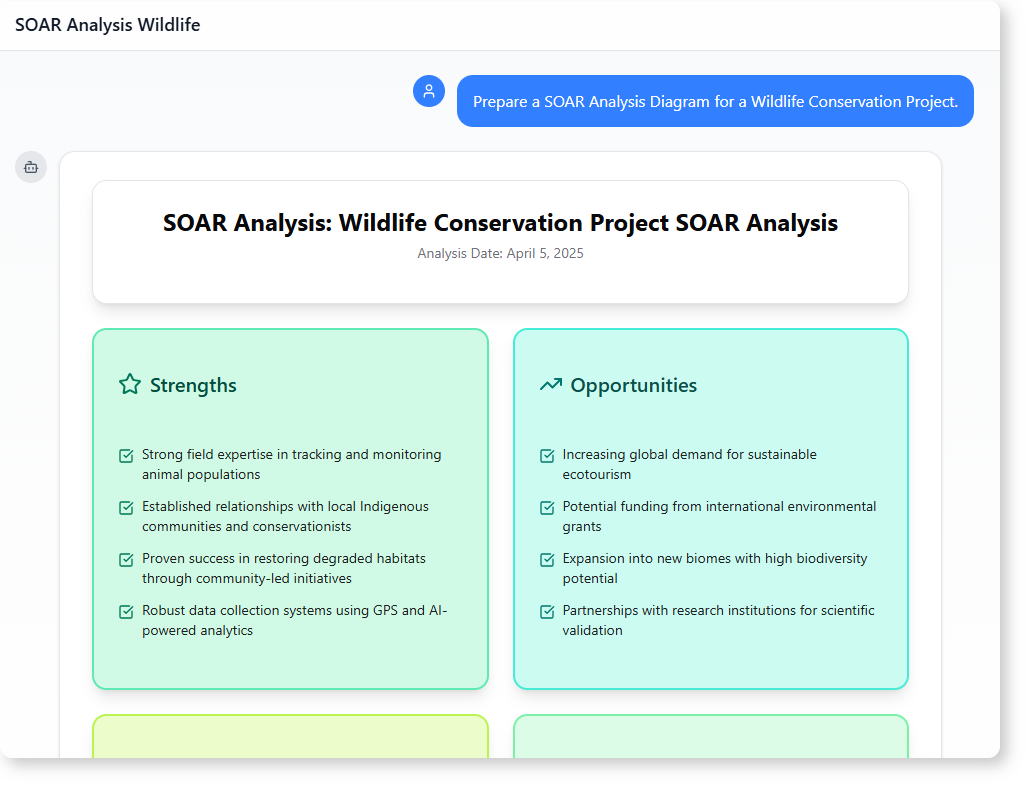Now Reading: How AI-Powered Modeling Software Turns Wildlife Conservation Goals into Clear Action Plans
-
01
How AI-Powered Modeling Software Turns Wildlife Conservation Goals into Clear Action Plans
How AI-Powered Modeling Software Turns Wildlife Conservation Goals into Clear Action Plans
How AI-Powered Modeling Software Helps Plan a Wildlife Conservation Project
Imagine you’re leading a team to protect endangered species. You know what you want to achieve—but how do you turn that into a practical, shared plan?
This is where AI-powered modeling software steps in. It doesn’t just generate diagrams. It helps turn abstract goals into structured, transparent frameworks that stakeholders can understand and act on.
In one real-world use case, a conservation project leader asked the AI to create a SOAR Analysis for a wildlife initiative. The result wasn’t just a list—it was a clear, visual map of strengths, opportunities, aspirations, and measurable results. This made it easier to communicate with partners, secure funding, and build community trust.
The journey didn’t start with a perfect plan. It began with a simple question: How can we turn our vision into a clear action roadmap? The AI-powered modeling software answered it—step by step.

The User’s Journey: From Idea to Action
The user was a project lead working with Indigenous communities and environmental researchers. Their team had strong field experience and data systems, but they needed a way to present their work in a way that stakeholders could easily understand.
They didn’t need to build a diagram from scratch. They simply asked the AI to generate a SOAR Analysis Diagram for a wildlife conservation project.
Here’s what happened next:
-
The user initiated the session by asking: “Prepare a SOAR Analysis Diagram for a Wildlife Conservation Project.”
The AI interpreted this as a request to structure a comprehensive view of the project’s current state, focusing on internal strengths, external opportunities, long-term ambitions, and expected outcomes.
-
The AI generated a detailed SOAR Analysis with four clear sections: Strengths, Opportunities, Aspirations, and Results.
Each section was presented in a way that highlighted achievable goals and actionable insights—perfect for internal planning or stakeholder meetings.
-
After reviewing the diagram, the user asked: “Develop a presentation-style summary of this SOAR Analysis Diagram that could be shared with stakeholders.”
The AI responded with a clear, concise narrative that explained each section in simple language, using real-world context to show how the project would grow and succeed.
This wasn’t about technical complexity. It was about clarity. The AI helped turn data into a story stakeholders could follow.
Why This Matters for Conservation Projects
Traditional planning tools often fall short when it comes to balancing vision with practicality. A SOAR Analysis Diagram helps bridge that gap.
In this case, the strengths were rooted in real-world experience: local community ties and proven habitat restoration methods. The opportunities were grounded in global trends like sustainable tourism. The aspirations weren’t just aspirational—they included specific, measurable targets like reducing poaching and expanding protected areas.
What made this different from standard tools?
- It wasn’t just about drawing a diagram. The AI understood the context.
- The structure was built to support decision-making, not just documentation.
- The output was designed to be shared—ready for meetings, reports, or grant applications.
This is the power of AI-powered modeling software. It doesn’t replace human judgment. It helps organize it.
The Value of a Clear SOAR Analysis in Project Planning
A well-structured SOAR Analysis is more than a checklist. It becomes a living document that evolves as a project grows.
In this project:
- Strengths provided a foundation: trusted local experts, reliable data systems.
- Opportunities opened doors: funding from international grants, new biomes to explore.
- Aspirations gave direction: protecting 500,000 hectares, ending poaching, empowering communities.
- Results made progress tangible: 40% reduction in human-wildlife conflict, increased biodiversity, community engagement.
This clarity helps teams align on goals, prioritize actions, and track progress. It also builds confidence when pitching to donors or government bodies.
How AI Modeling Tools Support Real-World Decision Making
AI-powered modeling software isn’t about magic. It’s about helping users articulate their vision with precision.
When a project leader says, “We want to protect wildlife and involve local communities,” the AI helps translate that into a structured, actionable analysis.
This is especially useful in fields like conservation, where goals span time, geography, and culture. The AI doesn’t just generate diagrams. It helps identify what’s already working, what’s possible, and what’s needed to move forward.
The generated SOAR Analysis isn’t static. It can be adapted, shared, and discussed—making it a valuable tool for planning, communication, and fundraising.
Frequently Asked Questions
What is a SOAR Analysis Diagram and why is it useful?
A SOAR Analysis Diagram breaks down a project into four key parts: Strengths, Opportunities, Aspirations, and Results. It helps teams see what they already have, what’s possible, where they want to go, and what measurable outcomes they expect. This structure is especially helpful in project planning because it turns vague ideas into clear, shareable insights.
Can AI-powered modeling software generate a SOAR Analysis for conservation projects?
Yes. The AI understands the context of environmental and community-based initiatives. When prompted with a clear objective, such as “Prepare a SOAR Analysis for a wildlife conservation project,” it generates a realistic, well-structured diagram that reflects both existing capabilities and future goals.
Is the SOAR Analysis generated by AI suitable for stakeholder presentations?
Absolutely. The output is designed to be clear and accessible. With a presentation-style summary, stakeholders can quickly understand the project’s foundation, key goals, and expected impact—without needing technical knowledge.
How does AI-powered modeling software improve project communication?
It turns complex ideas into visual, structured narratives. Instead of relying on reports or meetings, teams can share a SOAR Analysis that clearly shows progress, direction, and value. This improves alignment across departments, partners, and communities.
Ready to map out your system’s interactions? Give our AI-powered modeling software a try at Visual Paradigm’s AI Chatbot today!
